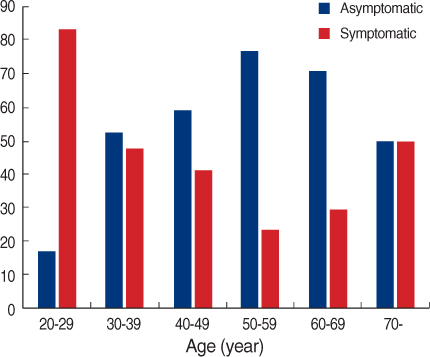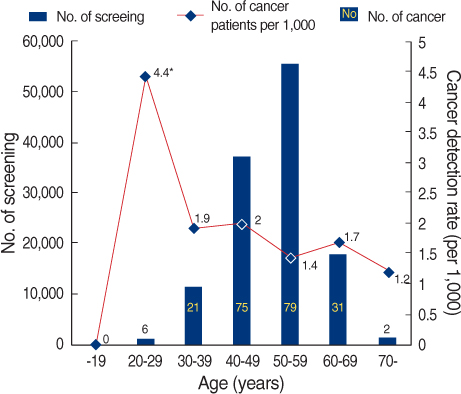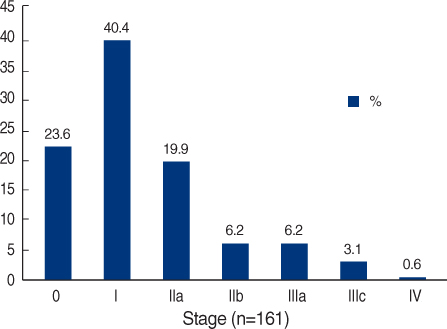J Breast Cancer.
2008 Dec;11(4):180-186. 10.4048/jbc.2008.11.4.180.
Breast Cancer Screening: A Medical Audit of the Screening Mammography Performed at One Institution for 10 Years
- Affiliations
-
- 1Department of Surgery, Kwandong University, College of Medicine, Cheil General Hospital and Women's Healthcare Center, Seoul, Korea. hmh1916@gmail.com
- 2Department of Radiology, Kwandong University, College of Medicine, Cheil General Hospital and Women's Healthcare Center, Seoul, Korea.
- KMID: 2286583
- DOI: http://doi.org/10.4048/jbc.2008.11.4.180
Abstract
-
PURPOSE: Screening for breast cancer has constantly been increasing since the benefit of screening for breast cancers was established. The purpose of this study was to investigate the efficacy of annual breast cancer screening at one institution for 10 years by conducting a medical audit.
METHODS
From March 1995 to July 2004, we performed 110,588 annual clinical examinations and mammographies on 58,024 women, who wanted to undergo breast cancer screening. Two hundred fourteen breast cancers were detected during screening, and one hundred sixty one of these patients were operated on. We then compared these results with the ideal rates for medical audits.
RESULTS
Of the 110,588 cases that were screened, the recall rate for further examination was 12.1% (n=13,423). The biopsy rate was 1.01% (n=1,116). Two hundred fourteen breast cancers were detected for a detection rate of 0.19%. The percent of stage 0 cancer among all the cancer was 23.6%, stage I was 40.4%, stage IIa was 19.9%, stage IIb and IIIa were a combined 6.2%, stage IIIc was 3.1%, and stage IV was 0.6%. The positive predictive value (PPV) based on the abnormal findings on the screening examinations was 1.6% (PPV1). The PPV when a biopsy or surgical consultation was recommended was 15.1% (PPV2). The percent of tumor found as stage 0 or I was 64% (103/161). The tumor found as minimal cancer (stage 0 or tumor lesser than 1 cm) was 38.5% (62/161). There were 38 cases of axillary lymph node metastasis (23.6%). The number of cases of cancers found per 1,000 cases was 1.7. The prevalence of cancer found per 1,000 first examinations was 2.3. The incidental cancer found per 1,000 follow-up examinations was 1.2. The recall rate for further evaluation was 12.1%. These results were compatible with the ideal rates for medical audits, except for the recall rate, the PPV1, the PPV2, and the cancers found per 1,000 cases.
CONCLUSION
On the base of these results, breast cancer screening was properly performed in this institution. Breast cancer screening using a clinical examination and a mammography is effective for the early detection of breast cancer.
Keyword
MeSH Terms
Figure
Cited by 1 articles
-
Breast Cancer Screening in Korean Women: Report of the National Cancer Screening Program in 2008
Dong Kwan Oh, Jung Im Shim, Mia Han, Yeonju Kim, Hoo-Yeon Lee, Jae Kwan Jun, Kui Sun Choi, Eun-Cheol Park
J Breast Cancer. 2010;13(3):299-304. doi: 10.4048/jbc.2010.13.3.299.
Reference
-
1. Humphrey LL, Helfand M, Chan BK, Woolf SH. Breast cancer screening: a summary of the evidence for the U.S. Preventive Services Task Force. Ann Intern Med. 2002. 137:347–360.
Article2. Smith RA, Saslow D, Sawyer KA, Burke W, Costanza ME, Evans WP, et al. American Cancer Society guidelines for breast cancer screening: update 2003. CA Cancer J Clin. 2003. 53:141–169.
Article3. Tabar L, Yen MF, Vitak B, Chen HH, Smith RA, Duffy SW. Mammography service screening and mortality in breast cancer patients: 20-year follow-up before and after introduction of screening. Lancet. 2003. 361:1405–1410.
Article4. Hendrick RE, Basset LW, Botsco MA. Mammography Quality Control Manuals. 1999. 4th ed. Reston: American college of radiology.5. American College of Radiology. Breast imaging and reporting and data system-mammography. 2003. 4th ed. Reston: 193–198.6. Agency for Health Care Policy and Research. Public Health Service. U.S. Department of Health and Human Services. Clinical practice guideline number 13: quality determinants of mammography. 1994. Rockville: 83. AHCPR Publication 95-0632.7. Tabar L, Vitak B, Chen HH, Duffy SW, Yen MF, Chiang CF, et al. The Swedish Two-County Trial twenty years later. Updated mortality results and new insights from long-term follow-up. Radiol Clin North Am. 2000. 38:625–651.8. 1998 MQSA (Mammography Quality Standards Act) final rule released. American College of Radiology. Radiol Manage. 1998. 20:51–55.9. Spring DB, Kimbrell-Wilmot K. Evaluating the success of mammography at the local level: how to conduct an audit of your practice. Radiol Clin North Am. 1987. 25:983–992.10. Sickles EA, Ominsky SH, Sollitto RA, Galvin HB, Monticciolo DL. Medical audit of a rapid-throughput mammography screening practice: methodology and results of 27,114 examinations. Radiology. 1990. 175:323–327.
Article11. Newcomer LM, Newcomb PA, Trentham-Dietz A, Storer BE, Yasui Y, Daling JR, et al. Detection method and breast carcinoma histology. Cancer. 2002. 95:470–477.
Article12. Lee JH, Yim SH, Won YJ, Jung KW, Son BH, Lee HD, et al. Population-based breast cancer statistics in Korea during 1993-2002: incidence, mortality, and survival. J Korean Med Sci. 2007. 22:Suppl. S11–S16.
Article13. Fajardo LL, Hillman BJ, Frey C. Correlation between breast parenchymal patterns and mammographers' certainty of diagnosis. Invest Radiol. 1988. 23:505–508.
Article14. Laya MB, Larson EB, Taplin SH, White E. Effect of estrogen replacement therapy on the specificity and sensitivity of screening mammography. J Natl Cancer Inst. 1996. 88:643–649.
Article15. Laya MB, Gallagher JC, Schreiman JS, Larson EB, Watson P, Weinstein L. Effect of postmenopausal hormonal replacement therapy on mammographic density and parenchymal pattern. Radiology. 1995. 196:433–437.
Article16. Christiansen CL, Wang F, Barton MB, Kreuter W, Elmore JG, Gelfand AE, et al. Predicting the cumulative risk of false-positive mammograms. J Natl Cancer Inst. 2000. 92:1657–1666.
Article17. Kim MH, Lee MJ, Oh KK, Lee KS. Screening mammography in a health promotion center for 5 year: results of medical audits. J Korean Radiol Soc. 2000. 42:859–864.
Article18. Choi HK, Park JM, Lee JH, Son BH, Ahn SH. Screening mammography: the results for four years. J Korean Radiol Soc. 2000. 42:1003–1008.
Article19. Feig SA. Auditing and benchmarks in screening and diagnostic mammography. Radiol Clin North Am. 2007. 45:791–800.
Article20. National Cancer Institute. accessed 2008 Nov 15. SEER: surveillance epidemiology and end results;http://www.seer.cancer.gov.21. Tabar L, Fagerberg G, Chen HH, Duffy SW, Smart CR, Gad A, et al. Efficacy of breast cancer screening by age. New results from the Swedish Two-County Trial. Cancer. 1995. 75:2507–2517.
Article22. Stomper PC, D'Souza DJ, DiNitto PA, Arredondo MA. Analysis of parenchymal density on mammograms in 1353 women 25-79 years old. Am J Roentgenol. 1996. 167:1261–1265.
Article23. Berg WA, Blume JD, Cormack JB, Mendelson EB, Lehrer D, Bohm-Velez M, et al. Combined screening with ultrasound and mammography vs mammography alone in women at elevated risk of breast cancer. JAMA. 2008. 299:2151–2163.
Article24. Korean Breast Cancer Society. Early screening of breast cancer in Korea. J Korean Breast Cancer Soc. 2002. 5:225–234.
- Full Text Links
- Actions
-
Cited
- CITED
-
- Close
- Share
- Similar articles
-
- Medical auditing of whole-breast screening ultrasonography
- Early screening for breast cancer
- Medical Audit of Screening Mammography at a Tertiary Referral Hospital Using the 5th Edition of Breast Imaging Reporting and Data System
- Benefits and Harms of Breast Screening: Focused on Updated Korean Guideline for Breast Cancer Screening
- Overcoming the limitations of screening mammography in Japan and Korea: a paradigm shift to personalized breast cancer screening based on ultrasonography




